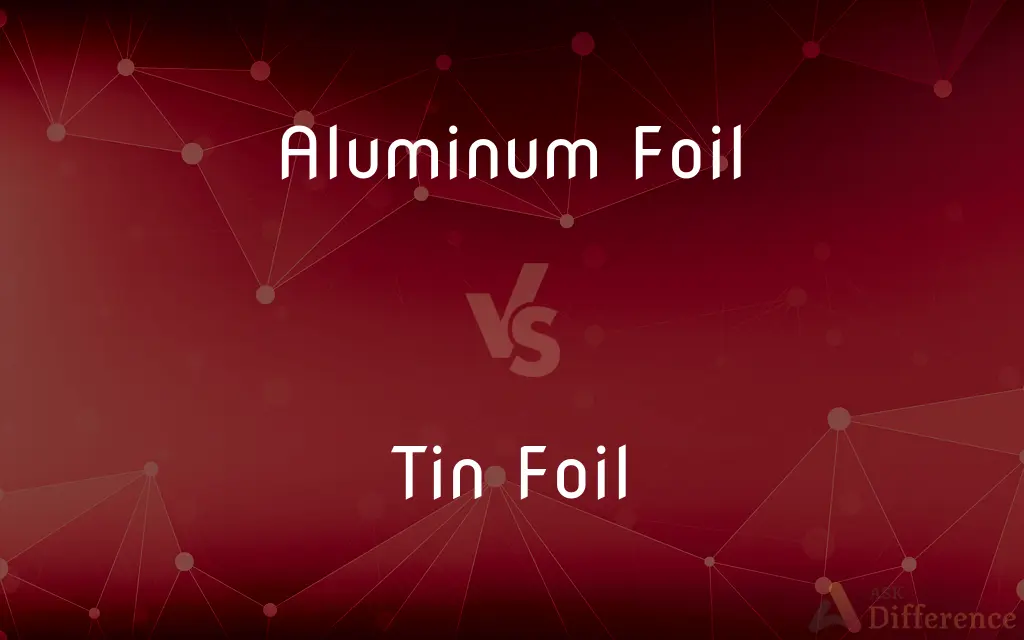Aluminum Foil vs. Tin Foil — What's the Difference?
Edited by Tayyaba Rehman — By Fiza Rafique — Published on December 26, 2023
Aluminum foil is a thin sheet of aluminum, often used in cooking. Tin foil, historically made from tin, is largely obsolete but the term persists in some regions as a colloquialism for aluminum foil.

Difference Between Aluminum Foil and Tin Foil
Table of Contents
ADVERTISEMENT
Key Differences
Aluminum foil and tin foil are both thin sheets of metal that have been used for various purposes over the years. Aluminum foil, as the name suggests, is made from pure aluminum. It is widely used in the kitchen to wrap food, as it helps to keep it fresh by preventing the growth of bacteria and fungi. Its versatility extends beyond the kitchen; aluminum foil can be found in various other industries and applications, from insulation to arts and crafts.
Tin foil, on the other hand, was made from tin in the past. It was a predecessor to aluminum foil and was used in similar ways. However, tin foil had certain limitations, such as a tendency to give food a slightly metallic taste. Because of this and advancements in production, aluminum became the preferred material for foil products.
Today, the term "tin foil" is often used colloquially to refer to aluminum foil, especially in certain regions or among older generations. This can be somewhat confusing, especially since actual tin foil is rarely found or used in modern times. Both products, while similar in appearance and utility, have distinct historical and material differences.
Aluminum foil is now a staple in many households, known for its shiny surface and flexible nature. Its properties, such as being a good conductor of heat and its resistance to light and oxygen, make it perfect for cooking and preserving food. In contrast, while tin foil's legacy still lingers in our vocabulary, it has mostly been replaced in practical use by its aluminum counterpart.
Comparison Chart
Material
Made from aluminum.
Historically made from tin.
ADVERTISEMENT
Usage
Commonly used today for cooking and other purposes.
Largely obsolete; replaced by aluminum foil.
Taste
Does not impart a metallic taste to food.
Could give a slight metallic taste to food.
Terminology
Accurately describes the material.
Often misused to describe aluminum foil today.
Availability
Widely available in stores today.
Rarely found in modern times.
Compare with Definitions
Aluminum Foil
A thin sheet of aluminum used for wrapping and preserving food.
She wrapped the sandwich in aluminum foil to keep it fresh.
Tin Foil
An older term still used colloquially to describe aluminum foil.
Hand me the tin foil, she said, pointing to the aluminum roll.
Aluminum Foil
A conductor of heat, ideal for grilling and roasting.
To avoid overcooking, he wrapped the fish in aluminum foil.
Tin Foil
Once common in kitchens before being replaced by aluminum variants.
Museums might display tin foil in exhibits about historic daily life.
Aluminum Foil
A household staple known for its shiny, reflective surface.
We made fun shapes by molding the aluminum foil.
Tin Foil
A historic predecessor to aluminum foil, made from tin.
Grandpa would always call it tin foil, even though he was using aluminum.
Aluminum Foil
A product used in various industries, from insulation to arts.
The artist used aluminum foil in her mixed-media piece.
Tin Foil
A metal sheet that sometimes imparted a metallic taste to food.
Some old recipes caution against the taste when using tin foil.
Aluminum Foil
A flexible metallic sheet effective for cooking and baking.
I covered the turkey with aluminum foil to retain its moisture.
Tin Foil
A material noted for its shiny surface, similar to aluminum foil.
The tin foil in the antique box still retained its luster.
Tin Foil
Alternative form of tinfoil(especially when used attributively)
Common Curiosities
Is tin foil the same as aluminum foil?
No, while tin foil historically referred to a foil made from tin, the term is now colloquially used to describe aluminum foil.
Did tin foil ever give food a metallic taste?
Yes, tin foil could impart a slight metallic taste to food, unlike aluminum foil.
Why is aluminum foil used in cooking?
Aluminum foil conducts heat, resists light and oxygen, and preserves the freshness of food.
What is aluminum foil?
Aluminum foil is a thin, flexible sheet of aluminum commonly used for cooking and preserving food.
Why do some people still call aluminum foil "tin foil"?
The term "tin foil" has persisted as a colloquialism, especially among older generations.
Was tin foil used in any historic inventions or devices?
Indeed, tin foil was used in early phonographs to record sound.
Are there other uses for aluminum foil beyond cooking?
Yes, aluminum foil is also used in insulation, arts and crafts, and various industries.
Do both foils have a shiny and a dull side?
Yes, but with aluminum foil, both sides function the same in cooking.
Is it safe to cook with aluminum foil?
Generally, yes, but acidic foods might react with it, so caution is advised.
Why did we switch from using tin foil to aluminum foil?
Aluminum foil is more pliable, doesn't impart a metallic taste, and is more readily available and cost-effective.
Can I find real tin foil in stores today?
It's rare, as aluminum foil has largely replaced tin foil in modern applications.
Was tin foil ever used in fashion or art?
Yes, like aluminum foil today, tin foil was also used creatively in various crafts and designs.
Is aluminum foil recyclable?
Yes, clean aluminum foil can often be recycled.
Is there any health risk associated with using tin or aluminum foil?
While aluminum foil is generally safe, consuming large amounts of aluminum may have health implications. It's advisable to avoid cooking acidic foods in aluminum foil.
Which side of the aluminum foil should touch the food?
Either side can touch the food; there's no significant difference in performance.
Share Your Discovery

Previous Comparison
KPI vs. KRA
Next Comparison
Void Agreement vs. Illegal AgreementAuthor Spotlight
Written by
Fiza RafiqueFiza Rafique is a skilled content writer at AskDifference.com, where she meticulously refines and enhances written pieces. Drawing from her vast editorial expertise, Fiza ensures clarity, accuracy, and precision in every article. Passionate about language, she continually seeks to elevate the quality of content for readers worldwide.
Edited by
Tayyaba RehmanTayyaba Rehman is a distinguished writer, currently serving as a primary contributor to askdifference.com. As a researcher in semantics and etymology, Tayyaba's passion for the complexity of languages and their distinctions has found a perfect home on the platform. Tayyaba delves into the intricacies of language, distinguishing between commonly confused words and phrases, thereby providing clarity for readers worldwide.
















































